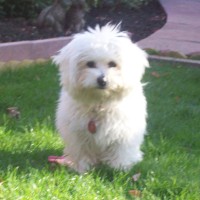Appearance of the Dualanese
|
| The Dualanese is a toy breed composed of a cross between a pure-bred Havanese and a pure-bred Bolognese. Common colors are white, black, black and tan, sable and gray, and the coat can vary according to the most dominant parent breed. The Havanese has a thick, silky, soft and light coat, and sometimes has watery eyes that cause tear stains. The eyes are generally almond-shaped and dark brown. They are sturdy little dogs with their tails carried over their backs and ears that droop and fold. A Bolognese is also quite robust, with large, round eyes and ears set high on the head. The tail is also carried curved over the back. |
Temperament of the Dualanese
|
| A Dualanese is likely to resemble the parent breeds, which means they will be very affectionate dogs who can be entertaining and love attention. They will make excellent companion dogs and love to be with the family and not left alone for too long. Small children will need to be supervised, but they are good with older children and other pets, even cats. They are intelligent dogs and love to play, but are happy to do whatever the owner does most of the time. Like the parent breeds, these are dogs that need early socialization to avoid the formation of bad habits, but can be trained fairly easily. They will respond best to positive reinforcement, especially when trained at home. They won't need much exercise to stay healthy and fit, and will often become attached to someone they follow devotedly. They may be a little wary of strangers. |
Needs and activities of the Dualanese
|
| Dualaneses are energetic dogs, but won't need much more than 30 minutes of exercise a day to maintain their fitness. They will happily play with their owners and do well with people of all ages. They can thrive in any house or apartment as long as they get daily exercise, either on walks, playing ball games in the yard or playing indoors in the evening. Like all dogs, they behave best when exercised regularly to avoid the formation of bad habits. They prefer warmer weather, so shouldn't be left outside when it's cold. |
Maintenance of the Dualanese
|
| Dualanese will need a moderate amount of grooming to keep them looking good. They should be brushed two or three times a week to remove loose hair and get rid of mats and dirt. They may need trimming, as both parent breeds tend to do, and also to wipe away tear stains around their eyes. Dualanese is likely to be hypoallergenic, so it's good for allergy sufferers and they won't have a strong smell, but a regular bath will keep their coat in good condition. Try to brush your dog's teeth every day and check the ears for any dirt, which can then be gently wiped off with the damp cotton ball. Nails should also be checked to see if they need trimming. |









 English (United Kingdom)
English (United Kingdom)